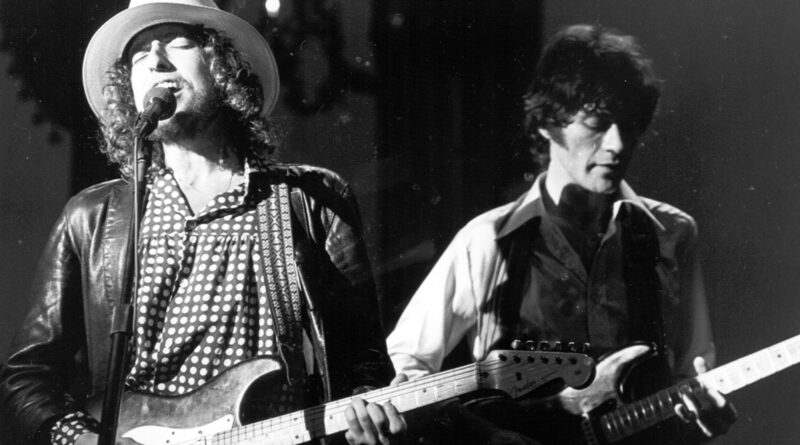How a Bob Dylan Drawing From ‘Basement Tapes’ Era Ended Up for Sale at an Antiquarian Book Fair
Artistes
Attendees can check out the sketching side of Bob Dylan this weekend in New York.
Bob Dylan and Robbie Robertson of The Band perform on stage for “The Band’s’ ‘The Last Waltz” concert at the Winterland Ballroom on November 25, 1976 in San Francisco, California.
Larry Hulst/Michael Ochs Archives/GI
While Bob Dylan has painted a handful of album covers and released several books of drawings over the years, the singer-songwriter’s fervent fans have had few chances to see original art pieces from his hand up close and personal.
But lo and behold! Fans in the New York City area will soon have an opportunity for a close encounter with some odds and ends drawings done by Dylan circa the 1967 recording sessions for the legendary The Basement Tapes album (released in 1975). And if you have a spare $60,000, you could be the one bringing it all back home.
Somewhat improbably, these captioned drawings – done on the blank side of a brown paper bag when Dylan was recording at Big Pink in Saugerties, N.Y. – will be on hand at the 63rd annual ABAA New York International Antiquarian Book Fair, which returns to the Park Avenue Armory in Manhattan from April 27-30.
The drawings, like the artist himself, are unusual. One depicts a man with a guitar waving and shouting a variation on a Basement Tapes lyric — “Long Distance Operator, This call is Not For Fun!”; another shows what the seller describes as “robot guitar machines”; and yet another features a visage not unlike the one that Dylan painted for the cover of 1970’s Self Portrait.
The story of how the drawings ended up at a book fair is just as unusual as the artwork – though significantly less mysterious. In 2022, Gabe Boyers, a dealer in antiquarian music manuscripts, art and books, was contacted by a man whose late sister maintained a friendship with Levon Helm of The Band during the heady Basement Tapes days. “[She was] in the middle of things with The Band, Eric Clapton and Dylan,” explains Boyers. After inspecting the materials, Boyers – whose gallery Schubertiade Music & Arts (at “B” Dry Goods) is selling the drawings – says he was struck by the way these pieces provided “an incredible impression of this moment and time.” Some of the materials he viewed included “calendars where she meticulously records which drugs they were taking on which day.”
The drawings, on the other hand, are a bit less meticulous. “Like Dylan and his lyrics – they’re difficult to pin down,” he says.
One thing that wasn’t difficult to establish, however, was the validity of the connection to Dylan. The previously seller’s late sister, who died tragically young, had an established history with The Band and Dylan during the period.
“There’s an incredibly deep provenance history that puts her in this room in a well-documented way,” he says. Not only that, but her brother had previously sold some of her personal items from that period via Sotheby’s, meaning the venerable auction company had already vetted items from her collection. Even so, Boyers – who has been doing authentication services for universities and libraries for nearly two decades – made a point to show the drawings to several major Dylan archivists, who confirmed the authorship. “You can tell instantly it’s the same hand, the same quirky confidence.”
You can gawk firsthand at that quirky confidence starting April 27, when the piece will be “very much on display” at the New York Antiquarian Book Fair. “The fair is an incredible opportunity for people to come see things that are normally in museums,” says Boyers, who is also selling a Beethoven manuscript with Ludwig van’s first thoughts on Symphony No. 9.
Elsewhere at the four-day event, music history lovers can see the design archive of Alex Steinweiss, the man who essentially invented album cover art in the 1930s as Columbia Records’ first art director (that collection is being sold by James Cummins Bookseller). Boyers notes that while not everyone has tens of thousands of dollars to drop, the fair offers plenty of items that go for hundreds of dollars.
That price point doesn’t, of course, include the 60k Dylan drawing – but that isn’t just any item. “There’s a lot of fake stuff on the market,” Boyers says. “The opportunity to get things that are undeniably from a certain time and have a strong provenance…. It’s not just a rare item. We know exactly when this was created, who it was made for, and who the other person’s handwriting is on it — she was in that room. It’s a special piece.”
Get weekly rundowns straight to your inbox
Subscribe

